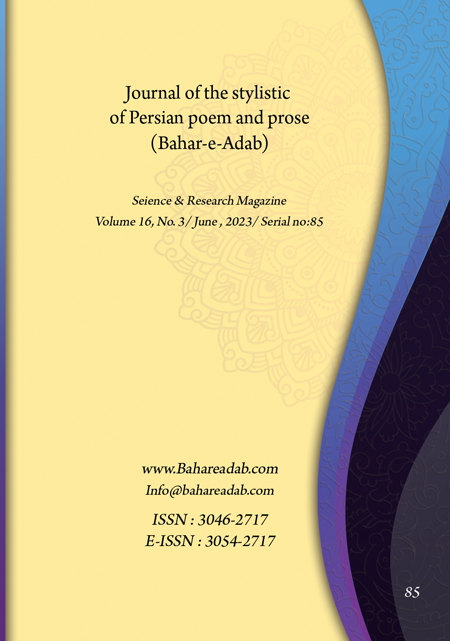- Count View : 355
- آدرس کوتاه شده مقاله: https://bahareadab.com/article_id/1464
- کد doi مقاله: Doi: 10.22034/bahareadab.2023 .16 .6854
Journal of the stylistic of Persian poem and prose
volume Number 16،
number In Volume 3،
،
issue Number 85
A Reflection on Thematic-Semantic Function of Proper Names in Attar`s Odes
Fattane Rostami , Fatemeh Klahchian (Author in Charge), Gholamreza Salemian
Abstract
BACKGROUND AND OBJECTIVES: Examining the poems of different periods, from different aspects related to form and meaning, can have decisive values. One of these aspects is to examine the use of proper nouns in poetry. Alam and proper names, including various and numerous details, have had an effective and pivotal presence in Persian literature, especially ancient and contemporary poetry, from the past until now. Understanding the meaning of many poems is linked with understanding the semantic and visual function of the special noun used in them. Considering this importance, the topic of this article is to investigate the function of proper nouns in the themes and concepts of Attar"s ghazal; An obvious and ponderable function. This review, in addition to making us face this poet"s ghazal from a new perspective, is an attempt to identify a distinctive part of ancient Persian poetry of which Attar"s ghazal is one of its important manifestations. The most important mission of this trend, which started with Sana"i, is to instill mystical, romantic, socio-political and Qalandaran concepts.
METHODOLOGY: The present research is a theoretical study that was carried out in a descriptive-analytical way, and the target version of Attar"s Diwan edited by Saeed Nafisi, published by Mendan Aviz, was examined.
FINDINGS: The findings show that the most use of proper nouns in Ghazal Attar is revealed with romantic concepts. In this thematic field, explaining the virtues of the beloved is the most obvious function.
CONCLUSION: Induction of mystical concepts and terms has the second position. Among these topics, mystical seeking has the most expression. The concepts of singing and playing are placed in the next place. The final frequency is also one of those socio-political functions; Emphasizing the condemnation of betrayal and hypocrisy. In Attar"s Ghazal, the order of usage of special nouns is: elements of nature, animals, persons, places, objects, and divine books.
Keyword
Proper Name
, Thematic-Semantic functions
, Traditional Odes
, Attar
- Abolghasemi, M. (2008). “Study of the characteristics of the evolutionary type of mystical poetry, specialized quarterly5 (17), pp.70-85.
- Anvari, H. and Ahmadi Givi, H. (2000). Persian grammar 2. 19th ed. Tehran: Fatemi, P. 81.
- Attar, F. (1987). Tazkare al-Awliya, by Mohammad Este’lami, Tehran: Zavvar, P. 28.
- Attar, F. (2011). Diwan Attar. Correction by Sa’eed Nafisi, Tehran: Zehn Aviz.
- Dehkhoda, A. (1998). Lexicon (under supervision of Moein, M. and Shahidi, S.j. Tehran: Tehran University press.
- Esfandiar, S. (2010). The development of mankind in Attar's passionary. Master degree thesis. Supervisor: Haghjoo, S. Babolsar: Mazandaran university
- Farshidvard, Kh. (2013). Today's detailed grammar. Tehran: Sokhan, P. 182.
- Foruzanfar, B. (1995). Description and criticism and analysis of Sheikh Fariduddin Mohamad Attar Neishaburi's Works, Tehran: Cultural Artifacts Association, P. 381.
- GHosheiri, A. (1995). Resaleh Qosheyriyeh, correction by Badi al zaman Foruzanfar, Tehran: Book translation and publishing company, P. 325.
- Hamadani, E. (1998). Tamhidat, correction by Afif Isran, 5th ed. Tehran: Manoochehri, P. 19.
- Homaei, J. (1999). Rhetoric techniques and literary industries, 15th ed. Qom: Homa, P. 124.
- J’afari, F. (2007). The sun in Shams's ghazals, Hafez monthly journal. Nr.41, pp.56-58.
- Keshavarz, K. (2005). A thousand years of Persian Prose by Faridudin Attar. 6th ed. Tehran: Elmi & Farhangi, P.616.
- Mir Ghaderi, S.F. (2005). “A comparative study of the characteristics of love in the poetry of Hafez and Ibn Farez of Egypt”, Journal of social and human sciences of Shiraz University, 22(3) PP. 165-184.
- Mokram, E. (1996). Arabic Language, 5 Beirut: Dar Sader, P. 128.
- Nakhsahbi, Z. (2003). Selk al0soluk. Tehran: Zavvar, P. 6.
- Natel khanlari, P. (2009). Persian grammar. Tehran: Toos, P. 166.
- Nikrooz, Y. (2008). “Study of the mystical concept of pain in Attar's poetry”, Kavoshname, 9 (17), PP. 209-247.
- Rastgar fasaei, M. (2001). Types of Persian poem. 2nd ed. Shiraz: Navid, PP. 525-527.
- Razi, N. (2005). Mersad al-ebad. By Riahi, M. 6th ed. Tehran: Scientific and cultural, P. 261.
- Razmjoo, H (1997). Literary types and their effects in Persian language. Mashhad: Astan Quds Razavi, P. 82.
- Ritter, H. (1998). The sea of life, Translated by Abbas zaryab Khooei and Mehrafagh baiburdi, 2nd ed. Tehran: Al Mahdi, P. 127.
- Sajjadi, S.J. (2000). Dictionary of mystic terms and interpretations. 5th ed. Tehran: Tahoori, PP. 580-581.
- Shafiei kadkani, M. (2008). Qalandariyeh in history, 3nd ed. Tehran: Sokhan, P. 307.
- Vahidian Kamyar, T. (2013). Persian grammar. Tehran: Samt, P. 192.
- Zarinkub, A. (1988). An exploration of Persian poetry, Tehran: Novin, P. 63.
- Zarinkub, A. (2001). The value of Sofia's heritage. 10th ed. Tehran: AmirKabir, P. 143.

